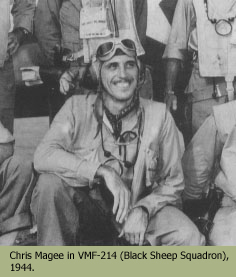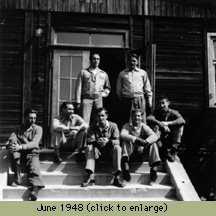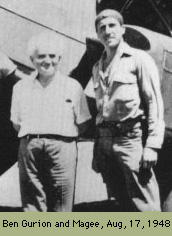Chris Magee
Chicago, Illinois
Combat Record
WWII: 9 kills (all in F4U?)
Story
Chris Magee was apparently one of those pilots addicted to
something about flying - the excitement, the danger, the competitiveness,
or perhaps the violence.
Although he was not Jewish, Magee had been troubled by the
plight of the SS St. Louis, later the subject of the movie "Voyage
of the Damned". The St. Louis contained 900 German Jews who
fled their homeland in 1939 only to be refused entry to Cuba and
the US.
 When war broke out, Magee headed to
New Orleans (?) in hope of finding a ship that would take him to England. When
that plan was thwarted, he headed north to Canada, where he secured himself
a place in the RCAF's pilot training program. The US Navy found him in Prince
Edward Island and invited him back home to fly. He accepted.
When war broke out, Magee headed to
New Orleans (?) in hope of finding a ship that would take him to England. When
that plan was thwarted, he headed north to Canada, where he secured himself
a place in the RCAF's pilot training program. The US Navy found him in Prince
Edward Island and invited him back home to fly. He accepted.
(Magee's second cousin, John Gillespie Magee, Jr., would also
fly for Canada, in Spitfires. He composed the famous poem "High
Flight".)
Magee became a Marine pilot, flying in the most famous Marine
flying unit of the war: VMF 214, better known as Black Sheep Squadron.
Known as "Wild Man" - or, behind his back, as "Maggie"
- and always wearing a bandanna on his head, Magee would score
nine victories, second most in the squadron, and earn the Navy
Cross for a solo attack on 15 Japanese divebombers.
After the war, Magee... did something or other.
 When fighting broke out in Israel, Magee's
wife commented that she was surprised he wasn't over there fighting. Magee signed
up to volunteer in Chicago in May 1948 and was in Ceske Budejovice for training
on the S-199 in June, with Lichter, Syd Cohen, Arnie Ruch, Rudy Augarten, and
others. By the end of the month, he was ready to take to the Israeli skies.
When fighting broke out in Israel, Magee's
wife commented that she was surprised he wasn't over there fighting. Magee signed
up to volunteer in Chicago in May 1948 and was in Ceske Budejovice for training
on the S-199 in June, with Lichter, Syd Cohen, Arnie Ruch, Rudy Augarten, and
others. By the end of the month, he was ready to take to the Israeli skies.
Magee was one of the pilots Leo Nomis met when he arrived
at Herzliya for the first time. Nomis describes him:
...The Gentile Chris Magee is with them. He has a red handkerchief
on his head and a pistol on one leg and a trench-knife on the other. Like
everyone else he is burned dark by the sun. (Nomis and Cull 1998)
Nomis further hints at Magee's aggressive nature when telling the story of
Bill Pomerantz's sick dog. Everyone  agrees it should
be put out of its misery, but no one will volunteer to do it:
agrees it should
be put out of its misery, but no one will volunteer to do it:
The dog tries to move and its legs twitch and it kicks Bill
in the crotch. There is laughter but then everyone is silent and there is
only the sound of the wind in the leaves. Chris Magee comes out of a room
behind the porch. He has the red handkerchief around his head and an automatic
pistol is in the belt of his flight suit. Bill gets up from the chair and
carries the dog over to where Magee is standing near the porch. No one says
anything and we can see Bill gesturing and finally Magee nods and they walk
around the corner of the building to the maize field. In a moment Bill comes
back without the dog and stops near the tent and then we hear a noise like
a tree branch breaking and Magee reappears with the gun still in his hand.
He motions over his shoulder with his thumb and Bill goes slowly out to the
field again. (Nomis and Cull 1998)
Magee disliked inaction as much as he hungered for action.
With the truce extending from mid-summer to October, Magee grew
bored and finally packed it in to go home just before hostilities
renewed.
Magee spent time in jail for bank robbery in the late 1950s, becoming one of
the few Naval Cross recipients to do so.

Click the badge to return to the squadron roster
 When war broke out, Magee headed to
New Orleans (?) in hope of finding a ship that would take him to England. When
that plan was thwarted, he headed north to Canada, where he secured himself
a place in the RCAF's pilot training program. The US Navy found him in Prince
Edward Island and invited him back home to fly. He accepted.
When war broke out, Magee headed to
New Orleans (?) in hope of finding a ship that would take him to England. When
that plan was thwarted, he headed north to Canada, where he secured himself
a place in the RCAF's pilot training program. The US Navy found him in Prince
Edward Island and invited him back home to fly. He accepted.
